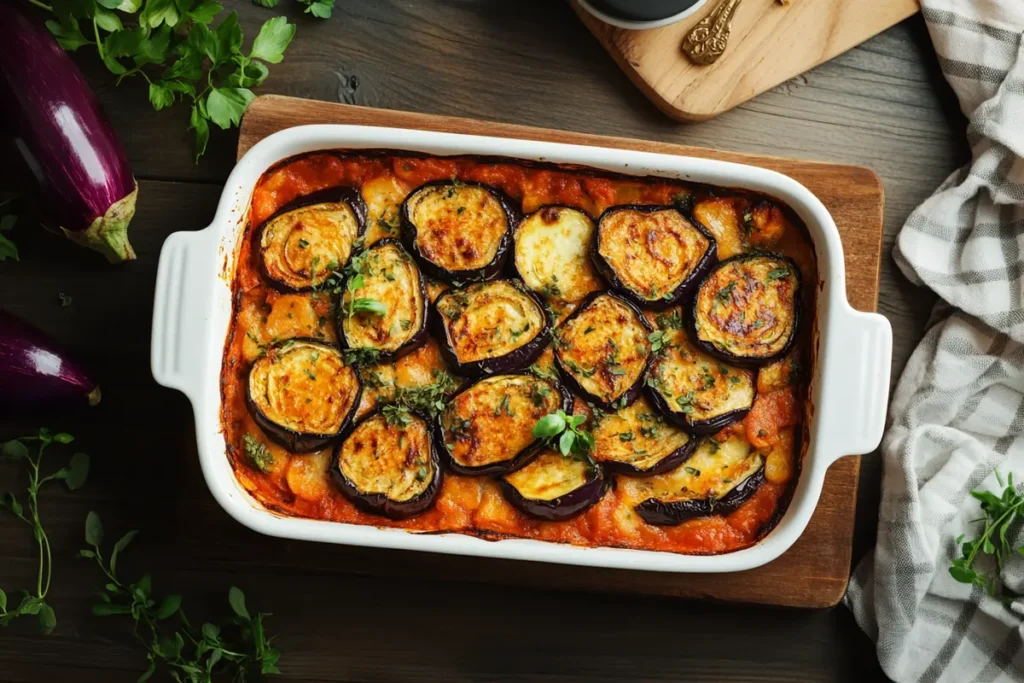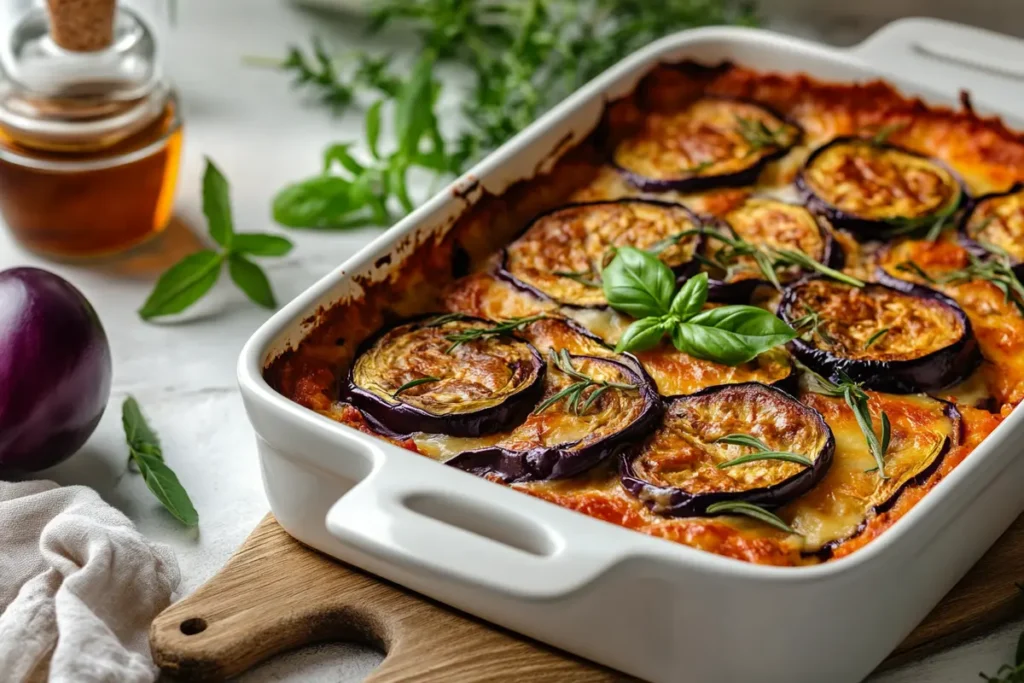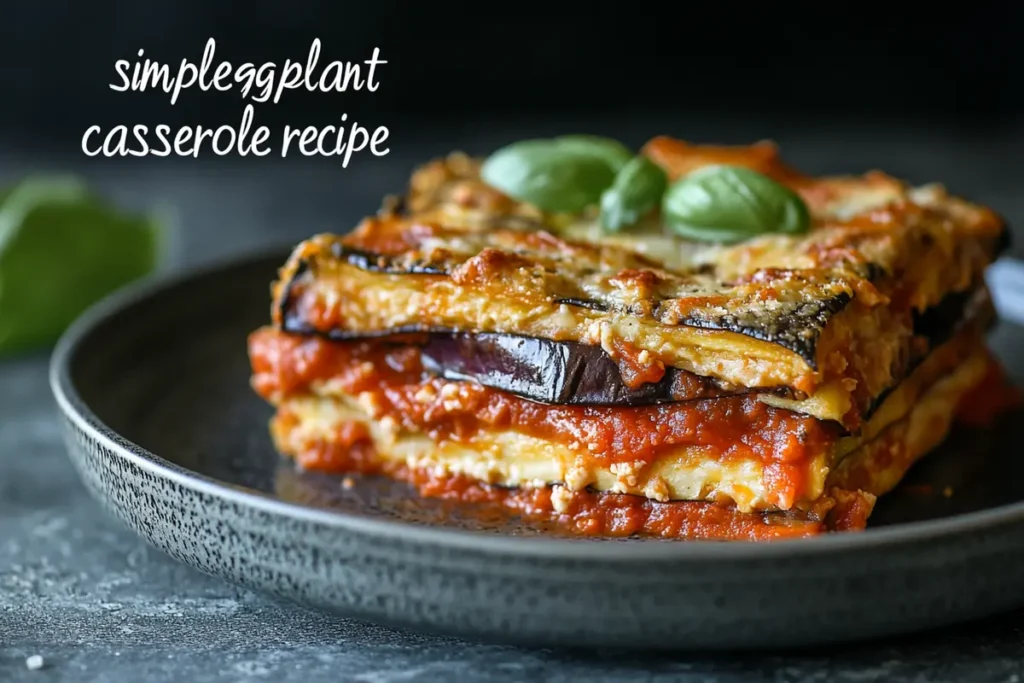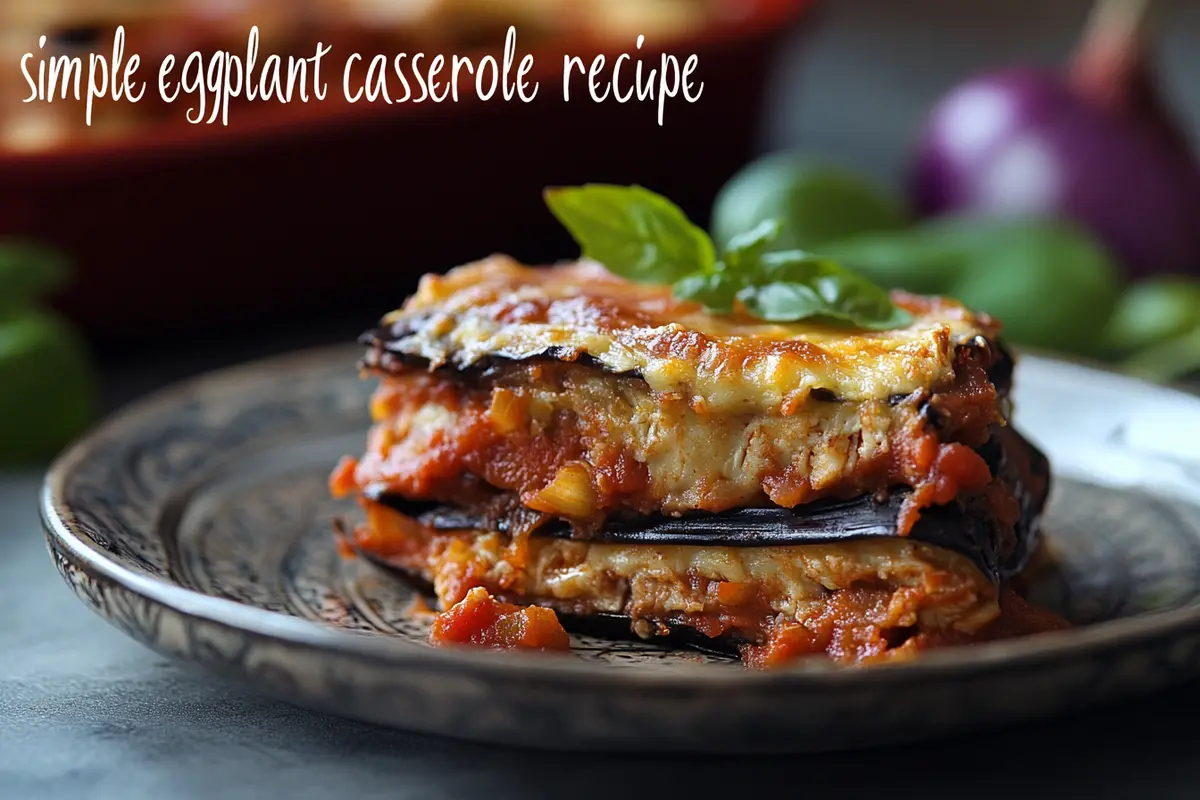Eggplant casserole is a timeless comfort dish that brings together tender layers of eggplant, rich tomato sauce, and a melty, savory topping. This simple yet satisfying recipe is perfect for family dinners, potlucks, or when you simply crave a warm, hearty meal. With a combination of fresh ingredients, aromatic herbs, and a blend of textures, this eggplant casserole offers an irresistible medley of flavors that will have everyone asking for seconds.
In this article, we’ll explore the origins of eggplant casserole, break down the essential ingredients and tools needed to create it, and provide a detailed, step-by-step guide to help you achieve a perfectly baked dish. Whether you’re an experienced home cook or a beginner in the kitchen, our easy-to-follow instructions and practical tips will ensure your casserole turns out beautifully every time.
The Charm of Eggplant Casserole
Eggplant casserole is more than just a dish—it’s a celebration of simple ingredients coming together in a delicious way. The eggplant, with its mild flavor and spongy texture, serves as the ideal canvas for absorbing the robust flavors of tomato, garlic, and herbs. Traditionally, casseroles have been a staple in home kitchens, passed down through generations as a reminder of family gatherings and comforting home-cooked meals.
This recipe pays homage to those classic family dinners, where the aroma of baked eggplant and tomato sauce filled the house. Its versatility means you can serve it as a main dish for vegetarians or as a hearty side that pairs wonderfully with grilled meats or a fresh green salad. The beauty of eggplant casserole lies in its adaptability: you can adjust the seasonings, add extra layers of cheese, or even incorporate other vegetables to suit your taste.
What You’ll Need
Before you begin, it’s important to gather all the ingredients and tools required for this recipe. Having everything at hand will make the cooking process smooth and enjoyable.
Essential Ingredients
- Eggplant: Use 2 to 3 medium eggplants. Look for eggplants that are firm, glossy, and free of blemishes. Their deep purple skin is a sign of freshness.
- Tomato Sauce: Approximately 4 cups of your favorite tomato sauce. A homemade sauce can elevate the dish, but a good quality store-bought sauce works well too.
- Onions and Garlic: One large onion, thinly sliced, and 4 cloves of garlic, minced. These aromatics form the flavor base of the dish.
- Herbs and Spices: Fresh basil, oregano, and thyme are ideal. Dried Italian seasoning can also be used as a convenient alternative. Salt, pepper, and a pinch of red pepper flakes add extra flavor and a slight kick.
- Cheese (Optional): For a richer version, add shredded mozzarella or Parmesan cheese. A dairy-free alternative can be used for a vegan twist.
- Olive Oil: A few tablespoons to lightly coat the eggplant and vegetables.
- Breadcrumbs: Optional, for a crunchy topping. Panko breadcrumbs add a light, airy crunch that contrasts nicely with the soft layers of eggplant.
Kitchen Tools
- Baking Dish: A large, oven-safe casserole dish (around 9×13 inches) works best.
- Knife and Cutting Board: For slicing eggplant, onions, and other vegetables.
- Large Skillet: To sauté the onions, garlic, and eggplant slices before layering them in the casserole.
- Mixing Bowls: To combine ingredients and seasonings.
- Aluminum Foil: Useful for covering the casserole during part of the baking process to retain moisture.

Step-by-Step Preparation
Follow these detailed instructions to create a layered, flavorful eggplant casserole that will impress your family and guests.
1. Prepare the Eggplant
Washing and Slicing:
Start by washing the eggplants thoroughly. Trim the stem ends and slice the eggplants into rounds about 1/4 to 1/2 inch thick. If you prefer a less bitter taste, you can sprinkle the slices with salt and let them sit in a colander for about 30 minutes. This process, known as “degorging,” helps draw out excess moisture and any slight bitterness. Rinse the slices lightly and pat them dry with a paper towel.
Pre-cooking the Eggplant:
For best results, lightly sauté the eggplant slices in a skillet with a drizzle of olive oil until they become tender and just begin to brown. This step not only softens the eggplant but also enhances its flavor by caramelizing the natural sugars in the vegetable.
2. Make the Sauce and Sauté Aromatics
Creating a Flavorful Base:
In the same skillet, add a bit more olive oil if needed, and sauté the sliced onion over medium heat until it turns soft and translucent. Add the minced garlic and a pinch of red pepper flakes, stirring for another minute until fragrant. These aromatics form the heart of the tomato sauce.
Combining the Sauce:
Pour in the tomato sauce and stir in fresh basil, oregano, thyme, salt, and pepper. Allow the sauce to simmer for about 10 to 15 minutes so the flavors meld together. If you have homemade tomato sauce, now is the time to use it for a more robust and personalized flavor profile.
3. Layering the Casserole
Assembling the Dish:
Preheat your oven to 375°F (190°C). Spread a thin layer of tomato sauce on the bottom of your baking dish. Arrange a single layer of eggplant slices over the sauce, slightly overlapping each other. Drizzle a little olive oil on top of the eggplant and season lightly with salt and pepper.
Adding the Sauce:
Once the eggplant layer is complete, spoon a generous amount of the tomato sauce mixture over it. If you’re using cheese, sprinkle a layer of shredded mozzarella or Parmesan at this stage. Continue layering with the remaining eggplant slices, sauce, and cheese until all ingredients are used, finishing with a top layer of tomato sauce.
Breadcrumb Topping (Optional):
For an extra crunch, sprinkle panko breadcrumbs mixed with a little olive oil and extra herbs over the final layer. This will create a beautifully golden and crispy topping as it bakes.
4. Baking to Perfection
Covering and Baking:
Cover the baking dish loosely with aluminum foil to help the casserole retain moisture during the initial baking phase. Place the dish in the preheated oven and bake for about 30 to 35 minutes. Removing the foil in the last 10 minutes of baking allows the top to become slightly crisp and bubbly, especially if you’ve added cheese.
Checking for Doneness:
The casserole is done when the eggplant is tender throughout, the sauce has thickened, and the top has a golden-brown hue. Use a fork to test the softness of the eggplant slices—if they are easily pierced, your casserole is ready.
5. Resting and Serving
Allow to Set:
After removing the casserole from the oven, let it rest for at least 10 minutes. This resting period allows the layers to firm up slightly, making it easier to serve neat slices.
Serving Suggestions:
Eggplant casserole is wonderfully versatile. Serve it as a main dish accompanied by a crisp green salad or as a side to complement grilled proteins. A side of crusty bread or a serving of steamed rice also pairs beautifully with the rich tomato and herb flavors of the casserole.
Variations and Creative Twists
While the classic eggplant casserole is delicious on its own, there are plenty of variations to suit different tastes and dietary preferences.
Vegetarian and Vegan Options
- Cheese-Free Version:
Omit the cheese entirely for a vegan version. Enhance the creaminess by adding a layer of dairy-free cheese or a dollop of cashew cream between the layers. - Additional Vegetables:
Incorporate other vegetables such as zucchini, bell peppers, or mushrooms. These additions not only boost the nutritional value but also add a variety of textures and flavors to the dish.
Protein Boosters
- Legume Additions:
For a heartier meal, mix in cooked lentils or chickpeas with the tomato sauce. These legumes provide extra protein and fiber, turning the casserole into a complete, satisfying meal. - Layering with Tofu:
Crumble firm tofu and add it between the layers for a plant-based protein boost. Tofu absorbs the flavors of the tomato sauce and herbs, creating a rich and savory profile.
Cheesy Variations
- Multiple Cheeses:
Experiment with a blend of cheeses, such as combining mozzarella with a sprinkle of Parmesan or Romano for an extra depth of flavor. - Cheese Crust:
For an indulgent twist, mix breadcrumbs with melted butter and cheese, then press it onto the top layer of the casserole before baking for a crunchy, cheesy crust.
Nutritional Benefits
Eggplant is not only versatile and delicious but also packed with nutrients. It is low in calories yet high in fiber, making it an excellent choice for a filling, nutrient-dense meal. The antioxidants in eggplant, particularly nasunin found in its skin, help protect the body from free radicals. Combined with the vitamin-rich tomato sauce and the healthy fats from olive oil, this casserole provides a balanced mix of macronutrients and micronutrients essential for a healthy diet.
Eggplant is also a good source of vitamins B1 and B6, as well as potassium and magnesium. These nutrients contribute to overall heart health, proper nerve function, and improved digestion. Whether served as a main dish or a hearty side, eggplant casserole is a nourishing addition to any meal plan.

Tips and Tricks for a Perfect Casserole
Achieving the perfect eggplant casserole is all about balance and attention to detail. Here are some tips to ensure your dish comes out perfectly every time:
- Uniform Slicing:
Slice the eggplant into even rounds to ensure they cook uniformly. Thicker slices will hold up better in the casserole, while thinner slices can become too soft. - Degorging the Eggplant:
If you’re concerned about bitterness, allow the sliced eggplant to sit with a sprinkle of salt for 30 minutes before rinsing and drying. This process also helps remove excess moisture. - Layering Technique:
Take your time layering the eggplant, sauce, and cheese (if using). A well-layered casserole ensures that every bite is balanced with flavor. - Season as You Go:
Taste your tomato sauce and adjust the seasoning before layering. A well-seasoned sauce can make all the difference. - Resting Period:
Let the casserole rest after baking. This not only makes serving easier but also enhances the overall flavor as the dish sets.

A Dish That Brings People Together
There’s something uniquely comforting about casseroles. They evoke memories of family dinners, long conversations around the table, and the shared joy of a meal made with care. Eggplant casserole, with its robust flavors and satisfying textures, is a dish that brings people together. It’s perfect for a casual family dinner or a special occasion where you want to impress without spending hours in the kitchen.
By following this simple recipe, you’ll not only enjoy a delicious meal but also create new memories with loved ones. Serve it at your next gathering, and watch as your guests savor every bite while sharing stories and laughter.
Final Thoughts
Simple eggplant casserole is a celebration of comfort food at its best—a dish that is both humble and elegant in its simplicity. With the right balance of fresh ingredients, aromatic herbs, and a perfectly layered assembly, this casserole becomes more than just a meal; it transforms into an experience that warms the heart and satisfies the palate.
From the careful selection and preparation of the eggplant to the rich tomato sauce simmered to perfection, every step in this recipe contributes to a harmonious blend of flavors. Whether you’re adapting the recipe for a vegan diet, adding extra protein, or simply enjoying the classic version, this eggplant casserole promises a comforting and memorable dining experience.
So, gather your ingredients, preheat your oven, and prepare to embark on a culinary journey that celebrates the timeless appeal of eggplant casserole. Enjoy every bite, and share the love by serving it to those who matter most.
